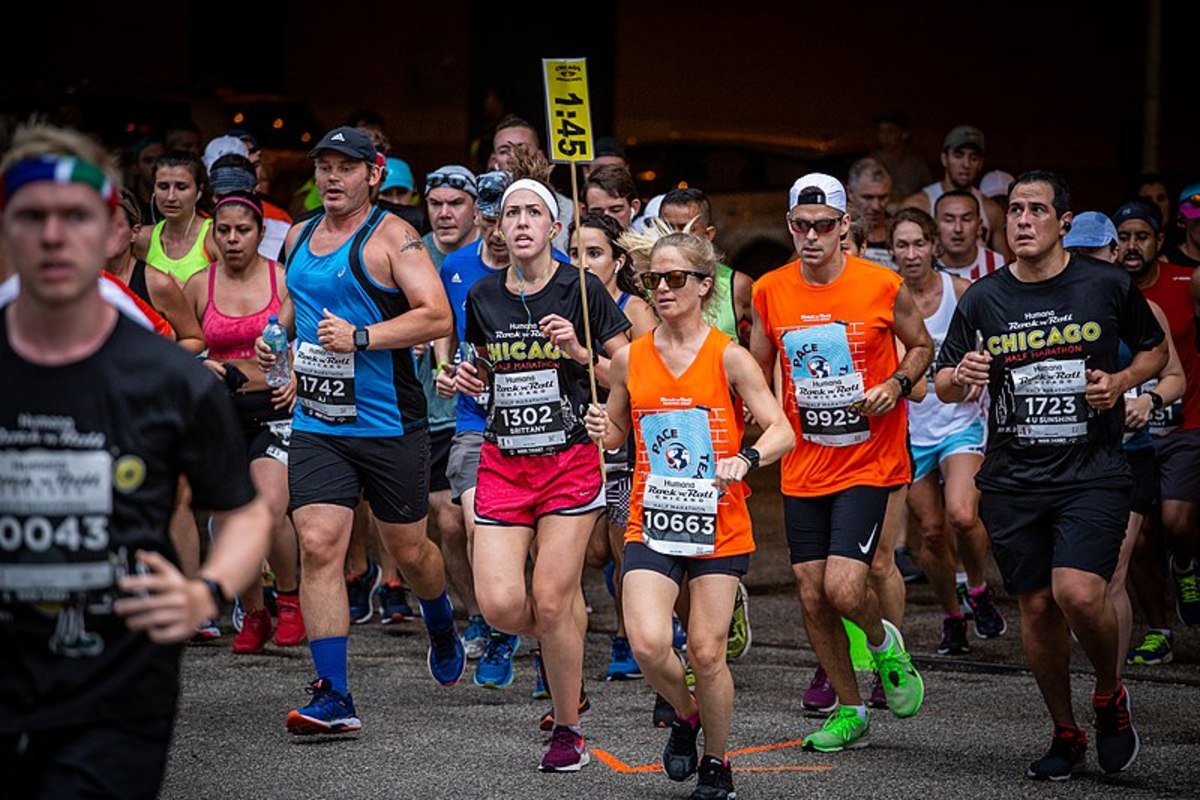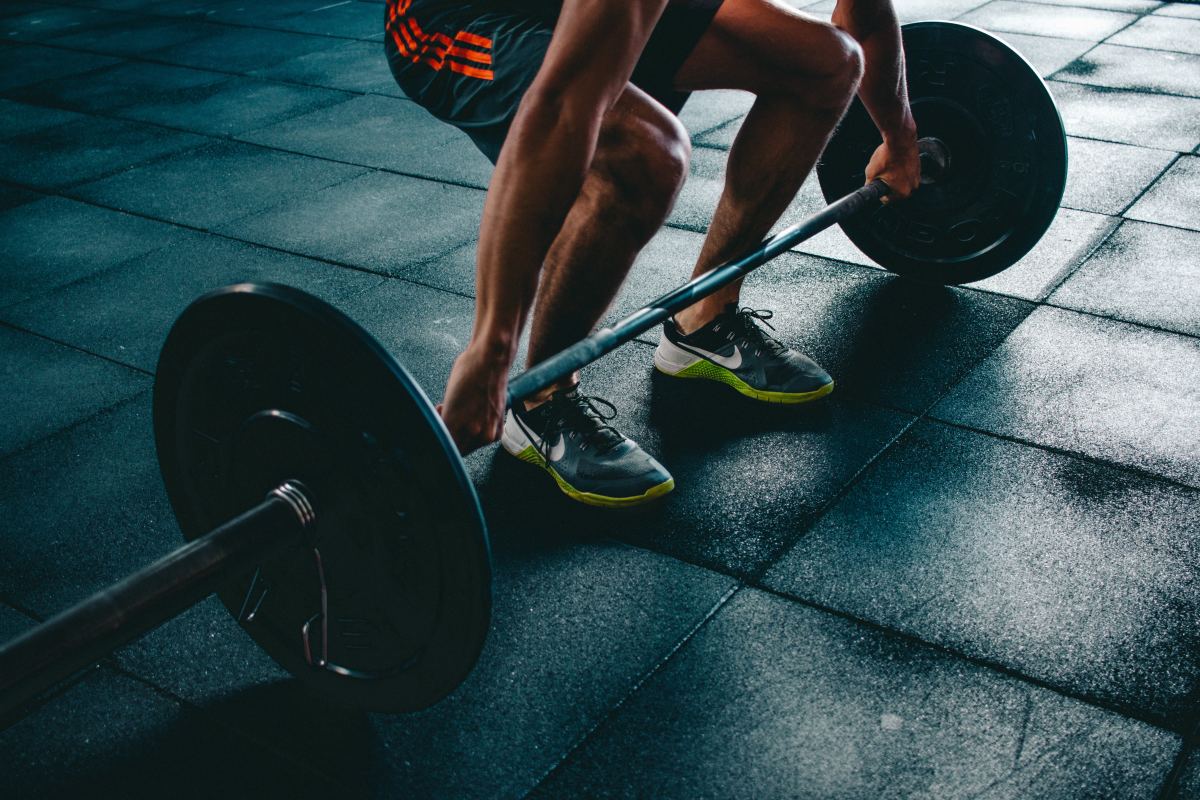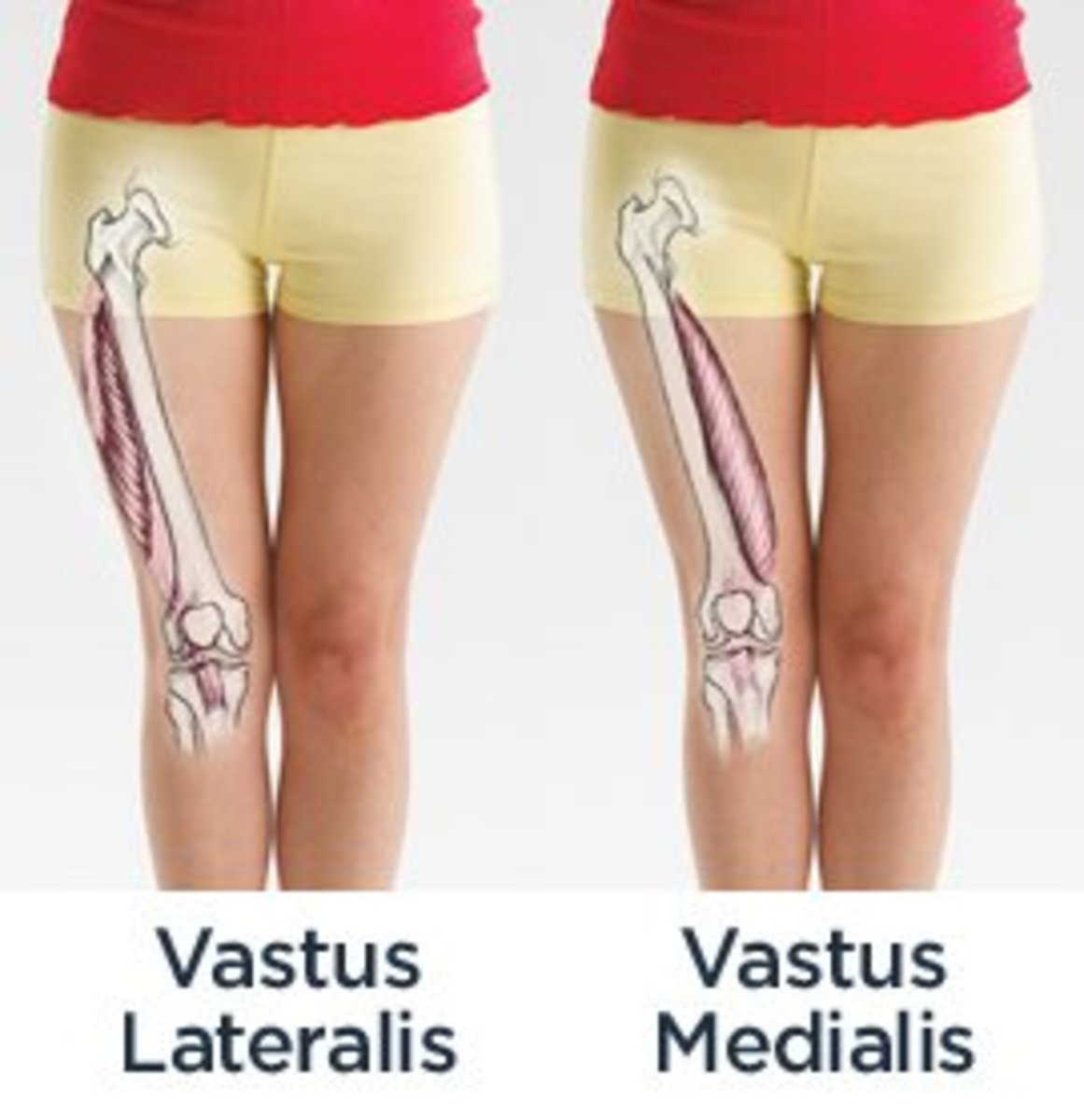Practice Running a Marathon Like a Kenyan
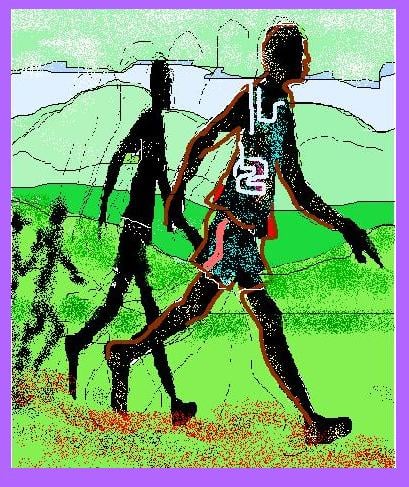
Kenya, in East Africa
Kenya reigns supreme in World Marathons
Kenyan Marathoners continue to dominate the global marathon scene. While this article does not pretend to tell you how to win marathons, here's one reason to study how Kenyans win Marathons.
- The Daily Nation of 11th Feb 2019 reported that Kenya's Kiptanui had won the Barcelona Half Marathon
- The Sunday Nation of 28 April 2019 reported that Kenya's Brigid Kosgei had won the London Marathon
- In 2018 the Standard reported that Mary Keitany had worn her fourth title at the New Your City Marathon
- In the Daily Nation of 22nd Dec 2017 it was reported that Kenya’s Daniel Wanjiru won the male marathon while Keitany had won the female race in London; Geoffrey Kamworor won the New York City Marathon; Eliud Kipchoge won the Berlin Marathon and her female compatriot Gladys Cherono won the female race.
- 2016 - London Marathon : Eliud Kipchoge wins the Men's race -Jemima Sumgong wins the Women's race
- 2015 - Berlin Marathon: Kipchoge won the Berlin Marathon despite losing on one shoe in what was described by an editor as a "shoe malfunction."
- 2014 - Kenyans won the Berlin and London Marathons
- 2013 - Kipchoge won the Humburg Marathon. He won his first individual world championship title in 2003 and won the London Marathon a record 4 times.
- 2012. The London Marathon - In the men’s race, Wilson Kipsang finished ahead of the pack at 2 hours, 4 minutes and 44 seconds. He was followed by compatriot Martin Lel at 2 hours, 6 minutes and 51 seconds. Kenyan women fared better than their men by taking all the top five places. Mary Keitany came in first (2 hours, 18 Minutes and 37 seconds), followed a minute later by Edna Kiplagat (2 hours, 19 minutes and 50 seconds). 24 seconds later, Prisca Jeptoo touched the finishing line with Florence Kiplagat and Lucy Kabu flocking in position four and five respectively. For the girl who came in 6th place, there is enough time to train for next years London Marathon. Never ever give up! The Boston Marathon - 2012 - In the boston Marathon of 16th April, which coincidentally was the 116th, it was a 1, 2, 3 win for Kenyan men and women runners. Kenyans also staked their claim in the Paris and Vienna Marathons, but managed third place in Rotterdam
The real secret of training marathoners in Kenya
People have done extensive research to find out out the secret behind the Kenyan winning streak. They have taken Kenyan foods to laboratories and found nothing really unique. White ugali is just a starchy from maize flour. Brown ugali fares a bit better as it is made from millet flour which is a cereal that has some protein among other nutrients. Ugali is the staple food in Kenya that is served with green vegetables that may include fried or roasted meat. All Kenyans eat it every other day, but not all Kenyans are marathoners. It is noteworthy that most marathoners in Kenya come from the Rift Valley Kalenjin Community. The specific marathon hot-spot is a high altitude area with lower oxygen than the rest of the lowlands and this is the same environment that produces Kenya's rivals in Ethiopia.
What researchers can agree on two things that favor Kenya's marathoners:
- The high altitude- if you can run well with little oxygen, you can run better with more oxygen.
- Kalenjin genes
Other world marathoners who want to give Kenyans a challenge can do nothing about to acquire Kalenjin genes, but they can go to Iten in Kenya and train with Kenyans. Iten has staked its place on the map as an international training camp for marathoners. You can google and find more details online about the Iten training camps.
Here I will guide you on how you can plan your runs to at least stay fit and healthy.
Iten, Hotbed of Kenyan Marathoners
Let's target to finish a half marathon
Before I give you my tips, let me start with a word of caution. The best marathoners finish the 42 kilometers in about two hours. The rank and file finish in double or triple that time. If you have never run anything longer than 10 kilometers, a marathon is not for you. Not just yet. I am writing this for you so that you can at least plan to finish a half marathon.
Running is invigorating and cheap and a great way to keep fit. You don’t need to be a member of a club to run and therefore no fees. All you need is your spare time. Running a Marathon is prestigious even if you are just part of the crowd, as long as you finish. Most races give certificates, some even give medals to all finishers. So if you run a half marathon, plan to finish and add that feather to your hat. I have run two half marathons. In the first one I arrived so late that all the certificates had been finished. I my second attempt, I finished first in my category of gents ‘over 40,’ which was about an hour after the winner had touched the tape with his chest. I am very proud of that certificate that puts me ‘first in category.’
Notice that I did not say, ‘How to win a half marathon like a Kenyan.’ If you did not run 5 to 10 kilometers everyday to school in a high altitude area with less oxygen than the coast line, don’t even think of beating the worst Kenya Marathoner – not even in a half marathon. Let’s just stick to finishing a half marathon. But if at one time you finished in the top 1000, these tips are not for you:
1. Get a medical check up – running continuously for two or more hours is straining for a body that has been sedentary. You need to be sure that your heart and lungs can take that kind of beating. Tell your doctor your plans and he will know what to look for. When you get the go ahead, move to the practice mode described below.
2. A journey starts with the first step – Have you been joggin? If yes, move to step number 3. If you have not been joggin, start with a fifteen minutes run. You run for 7.5 minutes and turn back homewards for the next 7.5 minutes.
3. Allow your muscles some rest - if you are well toned from frequent exercise, one to two days is sufficient. But if, like me you have not run for over a year, give your self a weeks holiday before the next run, except for stretching and other light exercises.
When you can run without straining, increase your practice run to a total of 20 minutes – 10 away and 10 homewards. Do this until you can run for a full hour. I did a 40 minute run up and down three hills and my body aches all over. By the end of the week I will be ready for a repeat.
4. Target a half marathon in your practice sessions – One Kenyan winner of a marathon was asked how he had prepared to win. He replied that he had run a marathon (42 kilometers) everyday for six months! Get it? If you are practicing for a half marathon don’t practice for a 10 kilometer race - target to ran 21 kilometers incrementally.
5. Stick to a routine - Due to busy schedules few can run every day. Your minimum ought to be a weekly schedule that leads you incrementally to the 21 kilometers. For example, run 5 kilometers when you are physically ready, followed by 8 the next week, then 10 and so on until you hit your target of 21. Once you can run 21 kilometers schedule to run short runs in the interval followed by your target of 21 kilometers, aiming at improving your speed in each race. If you finished in 2 hours and 40 minutes the first time, work at knocking off 5 mimutes in each run. The more times you have run 21 kilometers before the actual race the better.
One way to know how far you have run is to start from a major street and end on another major street. Go to your computer and Google Earth to find out the distance from point A and Point B. Multiply that distance by two to get the total kilometers back to your starting point.
When the day of race comes, you will have done 21 kilometers several times and your only concern will be to finish in the best time.
6. Include uphill and downhill in your practice – In my first half marathon, I ran only on flat ground for distances much shorter than a half marathon. During the half marathon itself, I discovered to my dismay that the chosen route was full of hills and downhills followed by more hills and downhills - endlessly. It was sheer torture. Going uphill reduced my pace to a walk, while the veterans ran past me effortlessly at more or less same the pace they had used downhill. Needless to say, when I finished the race I could hardly walk for two hours. I had to sit in my favourite restaurant with my feet on another seat, cooling my heels, so to speak.
Quite a few runners fainted up the hills. I learned my lesson the hard way. I now choose a route with no less than three hills. That way, the body develops the necessary leg muscles for descending and the muscles for ascending simultaneously. You will surprise yourself by running uphill with ease after only three or four practice runs.
7. Lower your weight – have you ever seen an overweight athlete win any race? At least not in a marathon. I often wondered where they stored the fuel to run, since their bodies are usually so lean. Just Google and see how ‘bird-like’ their legs are – not an inch of fat. It seems the muscles have a way of storing glucose for use only when needed. That is why a marathoner can actually draw on this reserve to sprint the last one kilometers of the race. I am not a nutritionist so please consult one. Cutting the starch in your meals by half and compensating with vegetables, fruits and nuts will help. Light weight people have less kilos to transport uphill and downhill and running gets to be as easy as walking.
Not everybody believes that running Marathons is a healthy pursuit. If your doctor has given you the go ahead, you need not worry. However, you might like to read a pessimist's view of he Marathon and decide if it is really for you: http://www.thehealthyhomeeconomist.com/how-running-a-marathon-can-seriously-harm-your-health/
8. Warm up on the day of the race - on my first marathon, I was surprised to see the seasoned marathoners running all over like excited bees. I thought they were crazy to burn up so much glucose when the race was yet to start. But when the race started they were the first ones all the way to the finish line. In my next marathon, I had learned to keep busy stretching and skipping all over the place just like the pros. When the race started, I felt like running had been my only locomotion method ever since I was born – it was effortless. No wonder I was first in my category.
This is the time to find out which Marathon gives you at least six months of practice from now. Next take a piece of paper and plan your weekly practice schedule. Relish the idea of waving your hands in the air for the cameras at the finish line and go for it.
I hope these tips will guide you to finish line.
Jogging schedule, route and distance using Google Maps
Joggers usually stick to a routine, like running for a specified number of minutes, or running the same distance each time. Like all sports, the runner wants to improve on form buy achieving set goals. One goal would be to run for a longer time after a given period. For example if the jogger has been running for 15 minutes, this would be increased to 20 and then 30 over time. This is easy to monitor with an ordinary watch. The runner would run for half the desired time, and then turn back to cover the other half.
Increase your distance
One other goal would be to cover more distance after a given time. That would mean that the jogger would need to know how many kilometers he or she has been covering in each run. Unless one has used a car before and measured the distance using the car’s meter, the only other sure way is to use Google maps for estimates in kilometers.
For example if a jogger is practicing to run a half marathon, we know that a half marathon is 21 kilometers. The jogger must then have run a distance of 21 kilometers several times before the actual event. Let’s say that the jogger wants to run for only 10 kilometers to start with and then increase the distance over time. The jogger can look for a distance of 5 kilometers to run as the‘away stretch, and then turn back on the ‘home stretch to cover the other 5 kilometers (total – 10). With time, the distance can be increased to the target of 21 kilometers. This is how to use Google maps:
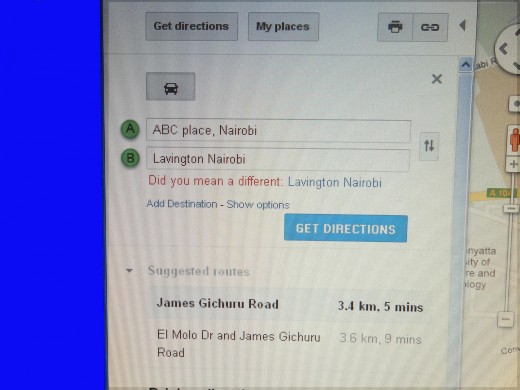
Go to www.google.com and select MAPS
Enter your City or Town in the search space and hit the ‘enter button’ – in my case I have selected Nairobi. Your city will be highlighted on the map with an ‘A’ tag.
On the top left corner you will see the words GET DIRECTIONS, directly below the Google Logo. Hit that button and a space to fill points A (my location) and B (the end of your journey) will show up. In the my location, type in the name of a shopping mall, petrol station, school, hospital or other feature that you are sure will show up on Google maps. If you are not sure, type one anyway with your City or town as the last word. In my case I have typed ABC place, Nairobi - which is a shopping area. In the second space, I have typed Lavington Shopping center, Nairobi. This is a spot down James Gichuru Road that has about three hills. Ensure you always end with the name of your City or town to avoid being sent to Europe or some other continent with similar names.
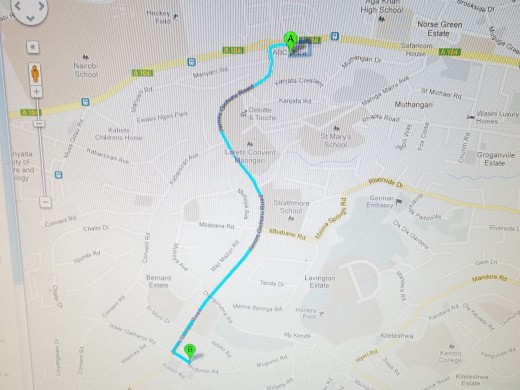
A blue line traces the distance from ABC place (tagged as A) to Lavington (tagged as B). Data appears on the left that tells me that the distance is 3.4 kilometers and a car can drive in 5 minutes. You should easily cover this in 20 minutes one way.
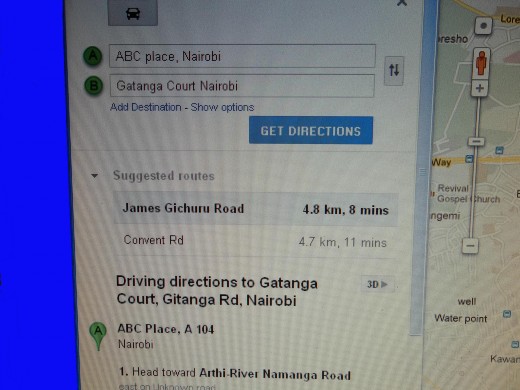
Using this method, you know that running from ABC place to Lavington and back will be 6.8 kilometers. You can use a stopwatch to find out how long that will take you. If your object is to work on your speed, then you will cover the same distance each time and aim at running faster. Later you can select a distance that indicates 5 and later 10 kilometers. Changing the destination to Gatanga Court on Google Maps gives me a distance of 4.8 kilometers which is almost 5. To and fro, I can assume to cover my new target of 10 kilometers.
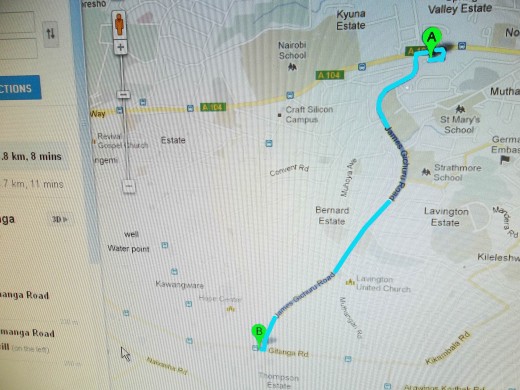
When you can run 10 kilometers one way and 10 on the home stretch, you are ready to attempt the half marathon which is only 21 kilometers. Go on now and use Google maps to plan your jogging routes.
This content is accurate and true to the best of the author’s knowledge and is not meant to substitute for formal and individualized advice from a qualified professional.
© 2012 Emmanuel Kariuki





